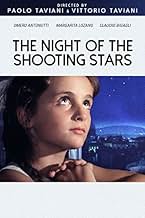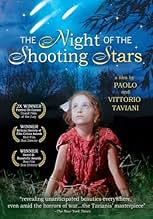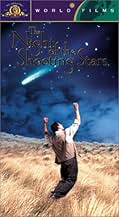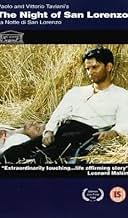IMDb-BEWERTUNG
7,2/10
4885
IHRE BEWERTUNG
Füge eine Handlung in deiner Sprache hinzuIn 1944, the residents of a small Italian town under Axis control flee their homes to seek out the liberating Allied forces.In 1944, the residents of a small Italian town under Axis control flee their homes to seek out the liberating Allied forces.In 1944, the residents of a small Italian town under Axis control flee their homes to seek out the liberating Allied forces.
- Auszeichnungen
- 19 Gewinne & 13 Nominierungen insgesamt
Sergi Dagliana
- Olinto
- (as Sergio Dagliana)
Empfohlene Bewertungen
The fraternal filmmaking team of Paolo and Vittorio Taviani recall the closing days of World War II with mingled affection and pain, looking back at the fate of one small northern Italian village (ostensibly their own childhood home) set in the path of opposing armies. Combining their typically lyrical approach to storytelling with a remarkable feel for setting, the two directors follow a small group of villagers as they steal through enemy lines one night in an attempt to meet the advancing Allied troops. Seen through the rose-colored lens of memory, the Taviani brothers' episodic reminiscences take the horror (but not the hurt) out of battle, reducing all the bloodshed and rage to a poignant and distinctly recalled tragedy.
Italian films of the late forties and early fifties were usually shot in the same neorealistic style. They showed he horrors of WW2, but also showed the fierce determination of Italians to free themselves from fascist rule. By the late 1950s. Italian cinema had pivoted to screwball romantic comedies and surrealist style of direction like Fellini. Style began to overwhelm Italian cinema and neorealism was soon a memory. This film not only revives some of that old-fashioned Italian neorealism, but also marries it to modern surrealism, in a blend of comedy and horror that one seldom finds in cinema today. It is a film not to be missed by true lovers of, not only Italian cinema, but of all cinema. Don't miss it.
There are many ways to portrait war, and the Tavianis choose a very circuitous one: By showing it through the eyes of a group of refugees - who, naturally, try to stay away from the fights as much as possible. Many of those refugees are real characters, with little stories of their own, so it's less a film about the actual WW2, but rather about how people react to war as a whole, how it can bring out the best (or worst) in a man and how it upsets everything you took for granted.
One of the nicest things about "La notte di San Lorenzo" is how there's always something lovely or funny to be found - comic or beautiful situations under the direst of circumstances, even if the laughter dies in your throat a few seconds later when violence cruelly rises again. This film celebrates life and humanity itself!
One of the nicest things about "La notte di San Lorenzo" is how there's always something lovely or funny to be found - comic or beautiful situations under the direst of circumstances, even if the laughter dies in your throat a few seconds later when violence cruelly rises again. This film celebrates life and humanity itself!
This film is an eye-opening look at Italian life during WWII. It reminds me of the stories my grandfather tells me of his life in 1930s Florence during the war, "We didn't have money for anything, not even water. The rich had it all." This movie shows us the sparseness of their lives, and the things that they still hold dear. There are scenes in which it is almost hard to watch, we are torn apart by the brutality of the war, but we are entranced by the people who are living through it. We meet ruthless fascists, and caring catholic priests and every moment describes to us the terrifying truth, and the hope that lets one continue. I could not imagine a more realistic, and emotional epic on the subject.
If you want to know how Italians lived and felt in the Second World War, how they managed the terror, you have to watch this movie. Have you imagined your neighbors collaborating with the Nazi-Fascist army? Have you imagined can't trusting in your relatives? Have you imagined yourself being chased and having to run away on foot for kilometers? Well, most of us have never faced this situation (some of us did) and this movie is one portrait of what Nazism/Fascism was to Europe.
Wusstest du schon
- WissenswertesThe church scene, where Germans bomb the church full of people, was based on real life events that took place in San Miniato (the birthplace of Paolo Taviani and Vittorio Taviani). However, more than two decades after this movie was made, the case was reopened and it was discovered, that the fatal bomb actually belonged to the American army, and hit the church accidentally.
- PatzerA man, likely Dilvo, raises watermelon to his mouth with both hands, but in the next shot is eating it only with the right hand.
- VerbindungenFeatured in Marcello Mastroianni: mi ricordo, sì, io mi ricordo (1997)
Top-Auswahl
Melde dich zum Bewerten an und greife auf die Watchlist für personalisierte Empfehlungen zu.
- How long is The Night of the Shooting Stars?Powered by Alexa
Details
- Erscheinungsdatum
- Herkunftsland
- Sprachen
- Auch bekannt als
- The Night of the Shooting Stars
- Drehorte
- Empoli, Tuscany, Italien(church bombing scene on Piazza Farinata degli Uberti)
- Produktionsfirmen
- Weitere beteiligte Unternehmen bei IMDbPro anzeigen
Box Office
- Bruttoertrag in den USA und Kanada
- 2.257.307 $
- Eröffnungswochenende in den USA und in Kanada
- 4.414 $
- 16. Aug. 2015
- Weltweiter Bruttoertrag
- 2.257.307 $
- Laufzeit1 Stunde 47 Minuten
- Sound-Mix
- Seitenverhältnis
- 1.66 : 1
Zu dieser Seite beitragen
Bearbeitung vorschlagen oder fehlenden Inhalt hinzufügen

Oberste Lücke
By what name was Die Nacht von San Lorenzo (1982) officially released in India in English?
Antwort



























